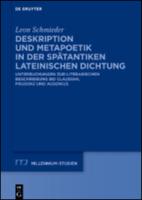Deskription und Metapoetik in der spätantiken lateinischen Dichtung
Untersuchungen zur literarischen Beschreibung bei Claudian, Prudenz und Ausonius
| dc.contributor.author | Schmieder, Leon | |
| dc.date.accessioned | 2023-02-14T10:11:14Z | |
| dc.date.available | 2023-02-14T10:11:14Z | |
| dc.date.issued | 2022 | |
| dc.identifier | ONIX_20230214_9783111012698_6 | |
| dc.identifier | OCN: 1356978734 | |
| dc.identifier.issn | 1862-1139 | |
| dc.identifier.uri | https://library.oapen.org/handle/20.500.12657/61345 | |
| dc.language | German | |
| dc.relation.ispartofseries | Millennium-Studien / Millennium Studies | |
| dc.subject.classification | thema EDItEUR::D Biography, Literature and Literary studies::DB Ancient, classical and medieval texts | en_US |
| dc.subject.classification | thema EDItEUR::D Biography, Literature and Literary studies::D Biography, Literature and Literary studies::DC Poetry | en_US |
| dc.subject.classification | thema EDItEUR::D Biography, Literature and Literary studies::DS Literature: history and criticism::DSB Literary studies: general::DSBB Literary studies: ancient, classical and medieval | en_US |
| dc.subject.classification | thema EDItEUR::N History and Archaeology::NH History::NHC Ancient history | en_US |
| dc.subject.classification | thema EDItEUR::N History and Archaeology | en_US |
| dc.subject.classification | thema EDItEUR::3 Time period qualifiers::3K CE period up to c 1500 | en_US |
| dc.subject.other | description | |
| dc.subject.other | Late Antiquity | |
| dc.subject.other | Latin literature | |
| dc.subject.other | poetics | |
| dc.title | Deskription und Metapoetik in der spätantiken lateinischen Dichtung | |
| dc.title.alternative | Untersuchungen zur literarischen Beschreibung bei Claudian, Prudenz und Ausonius | |
| dc.type | book | |
| oapen.abstract.otherlanguage | Literary description emerges as one of the central elements of late antique poetry. It serves a dual role in that it interacts both to represent multisensory perceptions and to break through the illusion it creates through metapoetic discourse. This self-referentiality makes the late antique descriptive a space of intense literary communication between poet and readership in different genres and contexts. This study systematically examines the textual strategies of description in selected works by the poets Claudian, Prudence and Ausonius, who were active between the late 4th and early 5th centuries. The texts are analysed with regard to ancient conceptualisations of descriptio and with the help of modern models of literary and cultural studies. The texts show both a continuation and an intensification of already existing traditions, which are expressed in a productive use of intertexts, a complex mediality and a textual world that plays with distance and proximity. | |
| oapen.identifier.doi | 10.1515/9783111012698 | |
| oapen.relation.isPublishedBy | 2b386f62-fc18-4108-bcf1-ade3ed4cf2f3 | |
| oapen.relation.isFundedBy | 5cb0e793-9d8a-4b83-9ee6-25b062467484 | |
| oapen.relation.isbn | 9783111012698 | |
| oapen.relation.isbn | 9783111007106 | |
| oapen.relation.isbn | 9783111012896 | |
| oapen.imprint | De Gruyter | |
| oapen.series.number | 100 | |
| oapen.pages | 296 | |
| oapen.place.publication | Berlin/Boston | |
| oapen.grant.number | 16TOA021 | |
| oapen.grant.program | Reihentransformation für die Altertumswissenschaften („Millennium-Studien") |

